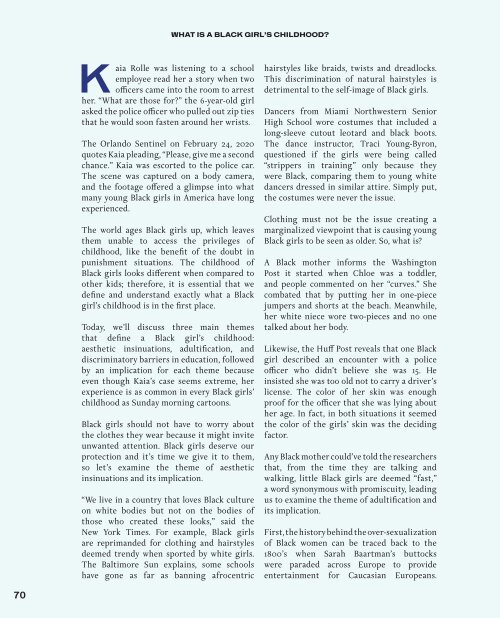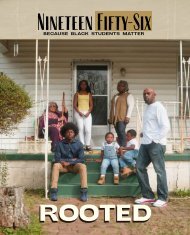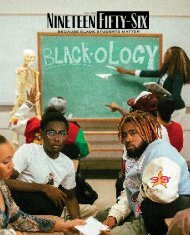Nineteen Fifty-Six Vol. 2 No. 5
This is the 2022 print edition of Nineteen Fifty-Six magazine. The theme "Movin' On Up" is inspired by the Black Panther Party.
This is the 2022 print edition of Nineteen Fifty-Six magazine. The theme "Movin' On Up" is inspired by the Black Panther Party.
You also want an ePaper? Increase the reach of your titles
YUMPU automatically turns print PDFs into web optimized ePapers that Google loves.
WHAT IS A BLACK GIRL’S CHILDHOOD?<br />
Kaia Rolle was listening to a school<br />
employee read her a story when two<br />
officers came into the room to arrest<br />
her. “What are those for?” the 6-year-old girl<br />
asked the police officer who pulled out zip ties<br />
that he would soon fasten around her wrists.<br />
The Orlando Sentinel on February 24, 2020<br />
quotes Kaia pleading, “Please, give me a second<br />
chance.” Kaia was escorted to the police car.<br />
The scene was captured on a body camera,<br />
and the footage offered a glimpse into what<br />
many young Black girls in America have long<br />
experienced.<br />
The world ages Black girls up, which leaves<br />
them unable to access the privileges of<br />
childhood, like the benefit of the doubt in<br />
punishment situations. The childhood of<br />
Black girls looks different when compared to<br />
other kids; therefore, it is essential that we<br />
define and understand exactly what a Black<br />
girl’s childhood is in the first place.<br />
Today, we’ll discuss three main themes<br />
that define a Black girl’s childhood:<br />
aesthetic insinuations, adultification, and<br />
discriminatory barriers in education, followed<br />
by an implication for each theme because<br />
even though Kaia’s case seems extreme, her<br />
experience is as common in every Black girls’<br />
childhood as Sunday morning cartoons.<br />
Black girls should not have to worry about<br />
the clothes they wear because it might invite<br />
unwanted attention. Black girls deserve our<br />
protection and it’s time we give it to them,<br />
so let’s examine the theme of aesthetic<br />
insinuations and its implication.<br />
“We live in a country that loves Black culture<br />
on white bodies but not on the bodies of<br />
those who created these looks,” said the<br />
New York Times. For example, Black girls<br />
are reprimanded for clothing and hairstyles<br />
deemed trendy when sported by white girls.<br />
The Baltimore Sun explains, some schools<br />
have gone as far as banning afrocentric<br />
hairstyles like braids, twists and dreadlocks.<br />
This discrimination of natural hairstyles is<br />
detrimental to the self-image of Black girls.<br />
Dancers from Miami <strong>No</strong>rthwestern Senior<br />
High School wore costumes that included a<br />
long-sleeve cutout leotard and black boots.<br />
The dance instructor, Traci Young-Byron,<br />
questioned if the girls were being called<br />
“strippers in training” only because they<br />
were Black, comparing them to young white<br />
dancers dressed in similar attire. Simply put,<br />
the costumes were never the issue.<br />
Clothing must not be the issue creating a<br />
marginalized viewpoint that is causing young<br />
Black girls to be seen as older. So, what is?<br />
A Black mother informs the Washington<br />
Post it started when Chloe was a toddler,<br />
and people commented on her “curves.” She<br />
combated that by putting her in one-piece<br />
jumpers and shorts at the beach. Meanwhile,<br />
her white niece wore two-pieces and no one<br />
talked about her body.<br />
Likewise, the Huff Post reveals that one Black<br />
girl described an encounter with a police<br />
officer who didn’t believe she was 15. He<br />
insisted she was too old not to carry a driver’s<br />
license. The color of her skin was enough<br />
proof for the officer that she was lying about<br />
her age. In fact, in both situations it seemed<br />
the color of the girls’ skin was the deciding<br />
factor.<br />
Any Black mother could’ve told the researchers<br />
that, from the time they are talking and<br />
walking, little Black girls are deemed “fast,”<br />
a word synonymous with promiscuity, leading<br />
us to examine the theme of adultification and<br />
its implication.<br />
First, the history behind the over-sexualization<br />
of Black women can be traced back to the<br />
1800’s when Sarah Baartman’s buttocks<br />
were paraded across Europe to provide<br />
entertainment for Caucasian Europeans.<br />
70


















